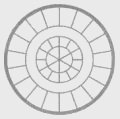
 |
Astrometry with Hokupa'a/QUIRC |
Note that there is a plate scale change between filters (most notably between the broadband and narrow band filters) and there is a variation in the detector position angle (~1 degree) from night to night. We are investigating the cause of these phenomena.
A double star of angular separation 2 arcsec at PA 108o was imaged in various positions, basically covering the entire array (4 images at 4x4 positions). The variations of plate scale were computed from the variations of the apparent separation of the stars. From that, a simple ad-hoc model for the distortion was computed. The figure below shows on the left the plate scale contours from this double star, referenced to the minimum plate scale in the image. The crosses mark the positions where the plate scale was effectively measured with this double star. The maximum variations of plate scale are about 1% or slightly more in the four corners. The center figure shows the simulated map with the distortion model. The right hand figure is the residual distortion after compensating the stars coordinates with the model. In the major part of the array, the residual distortion is smaller than 0.05%, with the exception of the lower left (0.15%) and lower right (0.07%) corners. The simple fitted model that was used links the "true" coordinates [xtrue, ytrue] to the "observed" coordinates [xobs, yobs] using the following relationship:
From this first pass analysis and model, we believe that the error on the edge pixels position should be smaller than 0.1 pixels. For instance, the true field of view can be calculated as being 1020.46 times the plate scale at the pixel (537,472), instead of 1024 times this value if the distortion was not corrected. Accordingly, the pixel surface changes in function of the position in the field. Althought this will have an impact on the PSF fitting performance, this should not affect directly the photometry, as even if they are more or less spread, the same number of photons are collected.
Note that the shape of the contour in the following figure are directly resulting from the particular geometry of the double star we used. Althought it does not appear centro-symmetrical, the overall distortion actually is.
Figure 2: Plate scale maps for distortion analysis
Several Hipparcos Double stars of large separation have been imaged during the runs. The galactic center fields were also checked with previous calibrated data (PUEO/CFHT) for an astrometric solution. Combining all these value gives 19.98 +/- 0.08 milliarcsec/pixel, which is the value we have adopted and given in the FITS headers. This value is for H and K'.
The value for CO and CO continuum is slightly different, at 19.74 milliarcsec/pixel, with the same uncertainty.
Along the calibration, the PA is consistent, giving the North at 0.30 +/- 0.07 degrees anticlockwise from the vertical axis. However, we have noticed some images with slightly different PA (from July 30 on), so it is always a good idea to check for applications sensitive to this parameter.
Content created October 2000; Francois Rigaut
Web page created 25 January 2001; Mark Chun